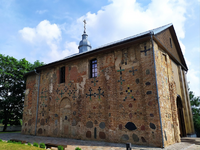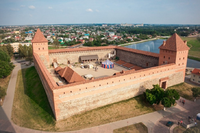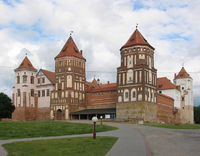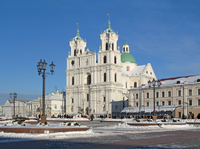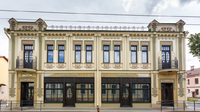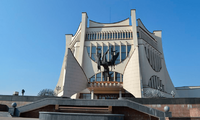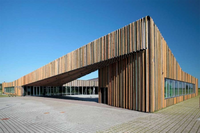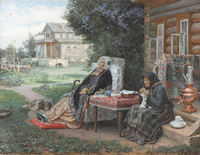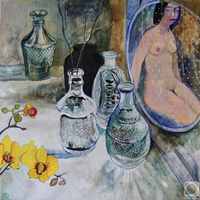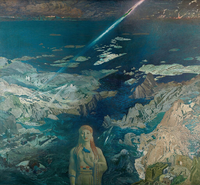Waisnorian Cultural Canon: Difference between revisions
Jump to navigation
Jump to search
No edit summary |
No edit summary |
||
| Line 157: | Line 157: | ||
| "The Plum Blossom Pattern" arc of "Shield" comics || Ilya Kukharchuk, Ivan Nazaruk || 2022 || "The Plum Blossom Pattern" presents a more down-to-earth and mature look at the superhero stories, combining optimism of the heroes with serious showdowns and moral dilemmas. Almost instantly, this arc was recognized as the first Waisnorian comic book masterpiece and a testament to the progress of Waisnor in this new medium. This comic series, along with other "Shield" comics would be released in United States and UK under DC Comics patronage, bringing Waisnoran "city comics" abroad. | | "The Plum Blossom Pattern" arc of "Shield" comics || Ilya Kukharchuk, Ivan Nazaruk || 2022 || "The Plum Blossom Pattern" presents a more down-to-earth and mature look at the superhero stories, combining optimism of the heroes with serious showdowns and moral dilemmas. Almost instantly, this arc was recognized as the first Waisnorian comic book masterpiece and a testament to the progress of Waisnor in this new medium. This comic series, along with other "Shield" comics would be released in United States and UK under DC Comics patronage, bringing Waisnoran "city comics" abroad. | ||
|} | |} | ||
==Visual arts== | |||
{| class="wikitable sortable" | |||
|- | |||
! Name !! Painter !! Year !! Signficance !! Picture | |||
|- | |||
| "Indian summer" || Radomił Zlotowski || 1805 || This painting depicts consequences of the drought in Waisnor and the suffering of the ordinary people left without any help. "Indian summer" is considered to be the first "critical piece" of Waisnorian art, speaking about how Waisnor was left by Carrelie to fend off the drought by itself. Zlotowski himself is considered of the the first artists to break into the Carrelian zeitgeist, with several liberal politicians applauding the painting for its message.||[[File:Chelmonski.png|200px|]] | |||
|- | |||
| "Grodno Sunset" || Alexander Karzhevich || 1833 || "Grodno Sunset", depicting Grodno after the Uprising for Reunification of 1832, which was crushed not so long before this painting was shown to the public. The subtext of fleeting freedom of Waisnor and the pessimistic tones of the painting were enough for the painting to be banned, "Grodno Sunset" was fully released only 20 years later. This painting is often regarded as the best painting of the Second Painter's Generation, with "Grodno Sunset" named as "descendant of Indian Summer". ||[[File:Grodno sunset.png|200px|]] | |||
|- | |||
| "Everything in the Past" || Sergey Kurganov || 1889 || Sergey Kurganov was a member of Peredvizhniki or The Wanderers - extremely influential Russian artist group which many-sided aspects of social life, often critical of inequities and injustices. Behind the beauty and calmness of this painting lies the subtext of Waisnor itself becoming calmer and more peaceful after failure of Uprising for Independence and the change towards more peaceful ways for achieving greater rights. Nowadays Kurganov is remembered as the most well-known painter of Waisnorian 19th century.||[[File:Everything In the Past.png|200px|]] | |||
|- | |||
| "Decanters" || Vasily Lozowski || 1907 || "Decanters" is described as one of the most scandalous Waisnorian paintings in history due the naked body portrayal and unconventional style of paintings, especially the artful depictiong of decanters and somewhat crude depiction of a female. "Decanters" became the precursor to the modernist period in Waisnorian art history, which will soon become the main art style for a decade. The painting is still remembered, with tributes to it being painted in 2000's in commemoration of the 100th anniversary.||[[File:Decanters.png|200px|]] | |||
|- | |||
| "Terror Antiquus" || Leon Bakst || 1908 || This painting, depicting the death of an ancient civilization, became the most iconic piece of Waisnorian art in history, with symbols from this painting incorporated into different art pieces ever since, the most important being depiction on Waisnorian money, illustrated on the back side of 500 thalers banknote. "Terror Antiquus" became the model for all other painters which were striving to achieve the same levels of artistry, bolstering the success of Waisnorian art at home and abroad. ||[[File:Terror Antiquus.png|200px|]] | |||
Revision as of 11:55, 29 August 2023
Waisnorian Cultural Canon was established in 2023 in Waisnor to "highlight the greatest works of art done in Waisnor and by Waisnorians". With the the committee assigned with the creation of the canon created in June of 2023, full list was revealed in August of 2023, consisting of 70 entries, divided into 7 categories 10 entries each: folklore, architecture, theatre, music, cinema, literature, and visual arts. It was also stated that the canon was open to further induction in the future. Waisnorian Cultural Canon also served as showcase of Waisnorian culture to the world with possibilities of future tours and translations of included works, especially in the WMCA aliance.
Folklore
| Name | Significance |
|---|---|
| Traditional Waisnorian dances, including šerahovka | Waisnorian traditional dances are one of the main and earliest parts of Waisnorian identity, developing on their own around 9th - 10th century and after that passing through generations to reach modern day. Dances accompanied many important moments of person's life, like a birth, wedding or funeral. The most well-known of them is šerahovka - a dance involving people lining up in two or more lines and dances involving interaction of said lines between together. In 2013, Waisnorian traditions of dances were included in UNESCO Intangible Cultural Heritage List. |
| Traditions and customs of Waisnorian wood-cutting | Wood-cutting was an integral part of Waisnorian culture for centuries and the one that is greatly cultivated in the present day through several centres of education. Wood-cutting is Waisnor greatly features geometrical and elaborate natural patterns, sometimes depicting scenes of wildlife and village life. Another distinctive feature is the usage of tree bark, either as framing or to highlight some parts of the cutting. Wood-cutting is present in modern-day Waisnor through not only souvenirs, but also home appliances like cupboards, doors and jewelry boxes. This tradition was also included in UNESCO Intangible Cultural Heritage List in 2017. |
| Marian celebration of the icon of Our Lady of Budlsau | The history of Marian celebrations begins in the beginning of 17th century, when several miraculous healings from such illnesses as blindness and epilepsy were attributed to the icon. Since then, there were recordings of many pilgrimages to Budslav, where the icon resided in Church of the Assumption of the Blessed Virgin Mary. Traditions of yearly pilgrimages survived through Russian Empire and Second Carrelian period, before being phased out during Soviet times. But during independence years, cult of the icon resurfaced with yearly pilgrimages resuming. In 2018, these celebrations were also included in UNESCO Intangible Cultural Heritage List. |
| Special art of flower wreaths weaving | For centuries, flower wreath weaving was one of the arts every young woman knew and cherished, with some continuing to do so in modern times. This art was prominent due to symbolism of resulting wreaths - every flower in it had a unique meaning, and combinations of flowers could telegraph some important messages (there were recordings of people communicating with each other with these wreaths). Nowadays this art is once again cultivated in rural area, and there are several shops in Waisnor specialising on making wreaths for special occasions. |
| Christmas King of the Hill celebrations | One of the main features of Waisnorian celebrations of Christmas is the massive King of the Hill play. In past centuries, there were times when all the boys and girls in the village were playing this game before returning to their homes for a Christmas feast. The tradition started to die down in 20th century, but in 2000's it managed to recover of once again become the integral part of Christmas celebrations. But there were some features added - the game could be played in building made from snow, like castles, or mix up with other activities like snowball fights. |
| Stork pattern of Miory | Stork pattern, which originated in the town of Miory somewhere in 14th century, involves sophisticated geometrical patterns and always depicts a stork, either flying or standing on his leg. Since then, the pattern was depicted on dresses, towels, curtains and more, with some variations in term of patterns but keeping in theme with two rules of Miory pattern. Over time this pattern became a symbol of pride among citizens of Miory and Waisnor as a whole, given that it was depicting the national animal of Waisnor. |
| Traditional fortune-telling carols of Waisnor | These carols were answers for Waisnorians wanting to look into future for centuries. Usually performed at the beginning of the year, these carols usually involved calling the higher forces to give them guidance and to tell them what awaits them in the future. These are many variations of these carols depending on the subjects - about love, harvests, birth of a child, death, and life in general. The carols still live in modern Waisnor through intense documentation of them in folklore works, and also sometimes used in popular music (for example in of the endings of "5th Department). |
| Brewing of traditional beer drinks | Waisnor has a robust beer culture, taking roots from Kievan Rus times when there were several beer-like drinks in Waisnor. Some of them did include hop or malt in the recipe, but brewers relied on local herbs, and so, drinks varied in alcohol concentration, with being considered safe even for children, while others were known as really strong. Brewing traditions were reintroduced to Waisnor in independence era, when such drinks became Waisnorian alternatives to Western craft beer. |
| Traditional Waisnorian folk dresses | Waisnorian dresses are one of the intergal parts of national folklore, often showing up in modern depictions of Waisnorian rural life. One of the main features of Waisnorian folk dress are the ribbons of different colours which are woven into the dress. Beads were also present in the dress, often accompanying the main part. There were also intricate and colourful parts woven on mostly white surface of the dress. Waisnorian folk dress is still used in modern times, often as a part of folklore celebrations, but some people can make their traditional dresses into wedding ones simply by adding a veil. |
| Vakanki | Vakanki are Waisnorian celebrations of relatives and friends and honorings of those who passed away, usually held in the summer. For centuries, Vakanki were a break for Waisnorians from summer work and allowed them to have some rest. Moreover, it was an opportunity for Waisnorians to meet with their family members who were far away for them rest of the year. Vakanki are one of the oldest cultural traditions of Waisnor, with first recordings about them made in Polish-Lithuanian Commonwealth period. After surviving Russian Empire, both Carrelie periods and Soviet Union, Vakanki are still frequently held in modern Waisnor, now also being held in cities. |
Architecture
Theatre
| Name | Writer | Year | Signficance |
|---|---|---|---|
| "Wild Strawberries" | Fedor Khudenko | 1886 | This play describes the lives and worries of Waisnorian elites after the Alexander II assasination, with heavy themes of fear of repressions after the more conservative Alexander III ascended to the throne. Overall, this is considered the first Waisnorian theatre play, with the glory amplified by the questions from censor boards. Moreover, this theme also established the theme of not only common people, but also elites striving for more freedom. |
| "Boyish Fables" | Ilya Kuzmichev | 1919 | "Boyish Fables" described the life of a boy named Nikita, who in form of a dramatized monologue tells the story of his life from 1913 to the present day, starting with Nikita working at the glass factory, going through revolutionary movement, Waisnorian People's Republic period and joining the Carrelian militia. That was the first Waisnorian play to be acclaimed worldwide, applauded for it well-developed story and original story ideas. That was also the first play to try to understand the WPR period, starting the trend in Waisnorian Carrelie and later Waisnorian emigree stage for several decades. |
| Scene and costume designs of Léon Bakst for Ballets Russes | Léon Bakst | 1908 - 1922 | Léon Bakst is the most well-known Waisnorian artist worldwide, mainly known for his scene and costume work for Sergey Dyagilev's Ballets Russes. Distinguished for their lavish, exotic and orientalist approach to art, his works were recognised all over the world, with exhibitions organized in USA, France and Carrelie, even more countries considering Ballets Russes on tour. Bakst was first Waisnorian to impact worldwide art tendencies - his work was one of the launching points of fashion for orientalism in European art in the beginning of 20th century. |
| "The Burden of Defeat" | Kazimierz Jaworski | 1921 | "The Burden of Defeat" tell a story of Waisnor returning to peaceful life after World War I and the soldiers living in the new reality, adjusting to the world without war. This play is considered to be a start of "Waisnorian Lost Generation", telling stories about the war and peace of the 1920's, while also being it's shining gem. The qualify of the writing is amplified by the superb actor performances, with stand-outs being works of Jadwiga Goldberg and Konstantin Mishin. |
| The art of the "Scenics" | Andrey Potapov, Anton Saroka and others | 1920-30s | "Scenics" were a group of theatre writers creating plays mixing up avant-garde and folklore in their art creating highly artistic and provocative works. The most well-known piece of "Scenics" art is "Wanderers" by Anton Saroka, becoming well-known in high class European theater circle. "Scenics" are one of the most important Waisnorian avant-garde performers, showing that folklore still had a right to be in modern Waisnorian culture, laying the groundwork for several generations of writers. |
| The Nikolai Fechin Ensemble | Nikolai Fechin | 1960-1980s | The ensemble which was founded by the entrepreneur Nikolai Fechin in 1964 was the most influential Waisnorian theatre group during the Era of Stagnation of Brezhnev's rule. The ensemble was highly popular with Waisnorians and neighboring social republics with their realistic plays constrasting the ordinary theatre fair of USSR, albeit there were not opposed to the communism. The most well-known plays by the Nikolai Fechin Ensemble are "Black Chamber" and "Sons of the Sky", applauded for portraying believable characters and writing unique stories, showing that even during a freeze after the Thaw, Waisnor could still write great works of art. |
| "The Day of Epiphany" | Mikhail Artemov | 1989 | "The Day of Epiphany" portrays he youths of Waisnor moving to Western pop culture and growing tired of Soviet regime, now enchanted by the different world. This play would be a the most important theatre work of perestroika Waisnor, solidifying the changes in Waisnorian pop culture initiated by "Our Armored Train". The play is also known for including for including American songs from singers such as Madonna and Led Zeppelin, which were performed unauthorized for almost 15 years until official approval was achieved in 2003. |
| "Between Dog and Wolf" | Anna Zhigulevtseva | 2006 | This play is well-known for an incredible psychological profile of a conflicted person, missing a direction in his life and searching for it. The play immediately received enormous critical praise for being a great analogy for the entirety of Waisnor at the most, still reeling from the impact of "Black Sunday". Moreover, the play is integral in rebuilding the respect in theatre in independent Waisnor, leading to a little renaissance in the theatre stage. |
| "Stalin Who Died" | Artyom Semeikin | 2007 | "Stalin Who Died" is a satirical play "based on the methods of a personality cult built around Stalin as a national myth", as Semeikin himself says. Reimagining post-war repression moments and the nature of Stalin's personality cult in a post-modernist light and sometimes adjusting them for the modern media, "Stalin Who Died" is a great exmaple of Waisnorian satire, main trait of which is taking things of which fun is made of to the extremes. This play was also one of the last successful cultural projects of "Riot 00's" mentality, in light of which "Stalin Who Died" could be considered a crescendo of the era. |
| Trilogy of Stefania Vishenya | Stefania Vishenya | 2014 - 2019 | Trilogy, which consists of "Backpacker", "Frontier" and "Dust and Bricks" is considered a great example of Waisnorian theatre renaissance with the masterful combination of drama and comedy and complex but optimistic characters. Theatre fans consider this trilogy to be the perfect example of Waisnorian art of 2010's, or least that in theatre. Also, "Backpacker" became the first Waisnorian play since Léon Bakst to be shown in United States. |
Music
| Name | Performer | Year | Signficance |
|---|---|---|---|
| Sonatas for piano and chamber music of Ivan Boyarko | Ivan Boyarko | 1780s - 1800s | Ivan Boyarko became the most prominent Waisnorian musician of the Grand Duchy of Waisnor period, with his sonatas and chamber music becoming well-known in Waisnor and neighboring territories. Their lightness and masterfulness had swayed many musical critics and fellow performers, transforming Boyarko into a respected performer. Ivan also became one of the first Waisnorians to grow out to the international fame, travelling all over Carrelie with the tour. |
| "Dzwonnica" and "Melodie pamiątkowe" | Piotr Madeja | 1825 - 1832 | Piotr Madeja began writing music after Waisnor was incorporated into Russian Empire and saw the worsening of civil rights which occured as a result of Decembrist revolt. Choosing the represent his worries in music, he wrote "Dzwonnica", honoring the Grodno Bell Tower as the symbol of the nation and "Melodie pamiątkowe" mourning the lives of people lost in the Uprising for Reunification of 1830. During next decades, his compositions would go through several periods of being banned due to their message, but over time the fame of Piotr grew as the main composer of the 19th century in Waisnor. |
| "All is Smoke and Mirrors" | Anton Makurin | 1900 | "All is Smoke and Mirrors" is widely recognised as the first modernist art piece of Waisnorian music and one of the first such in Waisnorian culture overall. The piece in widely recognised for its revolutionary style and overlying message of the coming century's incertaintly. In the future, "All is Smoke and Mirrors" was identified as the starting point of Waisnorian modernism, soon enough spilling over into all others forms of art. |
| "Popular opera" | Klementin Krauss | 1930s | "Popular opera" was a genre of opera created by the entrepreneur Klementin Krauss and immensely popular in the 1930s. Their main idea was the playful combination of regular opera, jazz and folk songs of Waisnor, mixing them up into entertaining adaptations of previous opera works, along with original productions. The "popular opera" was one of the first Waisnorian breakouts into the worldwide fame with Klementin Krauss showing his plays all throughout Europe. |
| Songs of Vladislav Brich | Vladislav Brich | 1960s - 1990s | Vladislav Brich was the first well-known Waisnorian songwriter, beginning his career in 1960s. Soon enough his songs, like "Why?" and "Forgotten Love" were performed by the famous Soviet singers and popular among the population, with him being renowmed for this sensual, but relatively lighthearted writing. His songwriting career lasted almost 30 years, lasting into the independent Waisnor era, with him writing songs for first post-Soviet pop stars. |
| "Čakannia" | Inna Lepikhova | 2000 | "Čakannia" by Inna Lepikhova was the most-expensive music video of the time in Waisnor, telling the story of people's expectations of the new millenium and how they could not be brought to reality. Overall, the song and the music video were renowned for their artistry, lyrical prowess and futuristic-sounding music. "Čakannia" was also recognised as the first musical masterpiece of independent Waisnor, showing that the music industry has fully recovered after the crisis of 90's. |
| "Infinity" album | EmiliA | 2004 | "Infinity" album, especially the most well-known song from that album, "Vnezapnost'" immediately became well-known for their music mixing rock and electronic tunes and provocative imagery. This album is highly regardeed as the beginning of the "shock-pop" era in Waisnorian music with different musicians using provocation and controversy as their main artistic method, although none have reached the level of cultural impact EmiliA achieved. She is also widely credited with planting the seede for the style of Waisnorian music prevalent from late 2010's. After influencing Waisnorian music for 20 years, "Infinity" is often called the most important Waisnorian music album of all time. |
| "Pri svete zvezd" | Elizaveta Dunina | 2007 | This song, telling the story of a full-scale alien invasion of Waisnor and a woman's life during it snatched the title of the most expensive Waisnorian music video, but apart from that it received accolades for telling a compelling story in space of 4 minutes and for reviving the hope of Waisnor in more traditional music after 2 years of "shock-pop" domination. Overall, "Pri svete zvezd" is credited with returning Waisnorian music to a more mature profile, setting the template for the next decade. |
| "Varjactva kachannia" | Rafael Nekrasevich | 2011 | "Varjactva kachannia" is widely known in Waisnor thanks to its performance in 2011 Eurovision Song Contest, where the song finished 2nd, this being the best result of Waisnor at this contest. But more than that, the song became one of the first international successes of Waisnorian art after achieving independence, showing that Waisnorian culture can be put equal to European or American one, this being the founding ground of current international cooperations with different European and Asian countries. |
| "White Album" | Various | 2016 | "White Album" was a collaboration album assembled by several underground artists to promote their music, which was often combining pop music with another genre, ranging from electronic to avant-garde, while also having more traditional singers in rock and rap genres. This album became highly successful and influential, launching (along with inspiration from "Infinity" album) the "Waisnorian New Wave", characterised by songs straying from regular pop as much as possible without losing a pop connection entirely. This style also became popular, transforming into the definitive style of Waisnorian music from late 2010's onwards. |
Cinema
| Name | Director | Year | Signficance |
|---|---|---|---|
| "I Come From Childhood" | Viktor Turov | 1966 | "I Come From Childhood", telling the story of two brothers living their lives during the World War II, is widely recognised as the first well-known and popular Waisnorian movie. Taking inspiration from Soviet Thaw movies, it set the standard for further Waisnorian movies and planted some long-lasting ideas, like the optimism and hope for the future present with the main characters. This movie is also notable for its music usage, especially for appearance of well-known musician Vladimir Vysotsky in this movie. |
| "Dirk" | Nikolai Kalinin | 1973 | This movie involving the adventure all over Russia during the Civil War to uncover a mystery of the dagger from a sunken ship became the first Waisnorian full-on adventure movie, instantly becoming popular all over Soviet Union and getting it's fair share of nostalgia. The legacy of this movie is also in that other adventure movies and TV series can trace their roots to the "Dirk", as it established several ideas prevalent in Waisnorian media like the combination of funny and serious moments. |
| "Family Circumstances" | Valery Rubinchik | 1974 | "Family Circumstances", telling the story of a family gradually becoming more distanced and facing the fact that this can't be fixed that easily is widely acknowledged with beginning the first "Golden Age" of Waisnorian cinema which would be highly inflenced by Polish "films of moral anxiety", included more mature themes and have an underlying theme of dillusionment with communist ideas. That period would last for more than 15 years, up to the dissolution of Soviet Union, while "Polish era" would last even longer, until the late 2000's |
| "I'll Take Your Pain" | Mikhail Ptashuk | 1981 | This being the first movie of soon to become legendary Mikhail Ptashuk, "I'll Take Your Pain" tells the story of a regular countrymen facing his morality and willingness to kill when he meets a former member of a Nazi auxillary police in his village. Immediately becoming known for going around Soviet censorship rules and the moral complexity of the characters shown, Ptashuk solidified his place in Waisnorian cinema scene and laid the ground for his future movies. |
| "White Dew" | Aleksey Dudaev | 1983 | Telling the story of a simple man and his family getting adjusted to being the city life as his village is getting demolished, this movie quickly became popular with the populace. "White Dew" also became the template for Waisnorian comedy movies in the future with it's wacky hijinks moments combined with emotional moments. This movie also became the first Waisnorian movie since "Dirk" to achieve all-Soviet popularity, getting a good press all over the country and even being awarded the trophy of the best comedy of the year by "Soviet Screen". |
| "Our Armored Train" | Mikhail Ptashuk | 1988 | The most well-known movie of Ptashuk and of Waisnorian perestroika, "Our Armored Train" is about a former camp guard confronting the crimes he committed and the crimes of communism as a whole, wondering, was he doing the right thing back then. This movie is recognised as possibly the most imporant Waisnorian movie in history and a big part of Waisnorian culture, with the release of this movie widely credited with launching perestroika in Waisnor in full gears and with references to this movie being found in movies and TV series decades later. |
| "Mister Designer" | Oleg Teptsov | 1995 | This movie, being about a mysterious detective looking for a missing woman and encountering a puppet master in pre-revolutionary Russia, is the first movie of independent Waisnor getting a big critical and lately popular response, this being a sign that Waisnorian cinema was gaining its footing after the breakup of Soviet Union and movie theaters system. "Mister Designer" also played a part of birthing Waisnorian fascination with supernatural, which would flourish in 2000's and 2010's. |
| "The Long and Confusing Game" | Alexander Osovetsky | 2005 | Movie about a woman divorcing her husband and later finding herself in a mental game with her former stalking man was lauded as a great example of "Waisnorian realism", the main movie genre of 2000's, exemplified by its attention to simple people and their problems, which by this point was drowning in shock value and unpleasantness. It's levels of nuance and sophictication bringed it international fame and so far the only Waisnorian Oscar for Best Movie in a Foreign Language in 2006. |
| "The Great Leader and Teacher" | Ivan Lagutin, Ernest Bochkov | 2009 - 2016 | This TV series tells the story of several different families living their lives in post-war Soviet Union, from end of war to the death of Stalin, tackling many different issues like the Stalin's cult of personality, antisemitism and repressions. "The Great Leader and Teacher" became the first Waisnorian TV series regarded as a world-class masterpiece, thus starting "Golden Age of Waisnorian TV", signified by appearance of many high-quality TV series, which were in many cases inspired by "The Great Leader". |
| "Modern Gods" | Artem Makarevich | 2017 | "Modern Gods" tells the story of the day when superheroes appeared in Waisnor, told through a combination of classic movie shooting, found footage and screen-life and their new-found impact on society. The new realistic, but optimistic view on superheroes became the showcase of "city comics" style of Waisnorian comics, which would influence other superhero productions onwards, like "Shield" and "Codename:Storm". This movie also was shown all around the world, becoming the gateway for Waisnorian superhero style in many countries, especially in USA and Japan, where Waisnorian comics would be sold soon enough. |
Literature
| Name | Writer | Year | Signficance |
|---|---|---|---|
| "The Neglected" | Ilya Galagush | 1826 | This book, telling the story of a pair of poor people embarking on a journey for a better life and describing their adventures in different cities of Waisnor and Carrelie, became one of the first notable Waisnorian novels, becoming popular with people in Carrelie. Also, since this book was released just before Waisnor became a territory of Russian Empire, this book was seen as a symbolic end of art of First Carrelian Period, and soon enough "The Neglected" would be censored in Russia. |
| "Crescent" | Nikolay Syrokov | 1848 | "Crescent" is about the life of a Waisnorian soldier sent to the Caucasian War, his relationships with fellow comrades and with local people, drawing some inspiration from "Hero of Our Time" by Mikhail Lermontov, but distinct in the more personal view of the war and complex interactions between characters. "Crescent" became the start of the first full-fledged writer generation of Russian Waisnor, "Tsitsillinists" which would release several other highly-acclaimed books and last for almost 20 years. |
| "Days and Nights" | Isaak Levinson | 1873 | This book is detailing a life of the ordinary Jewish family during preparations for a wedding and all the drama that comes with it, placing big emphasis on the authenticity of the rituals and character moments. Isaak Levinson was a prominent Jewish writer, one of the few writers that were open about their Jewish heritage and willing enough to show it in his work. "Days and Nights" were a big part of building a distinct Jewish identity in Waisnor, which always had a sizeable Jewish minority, along with helping with Waisnorian identity overall. |
| "Tales of Four Generations" | Konstantin Shudrov | 1902 | Novel details the history of the mysterious and mystical village, which over these four generations, or around 100 years, saw it's fair share of wizards, curses and mythical beasts showing up. Shudrov himself was a part of "The Lost Ones", the group of young of non-conformist writers which flourished in 1890's and 1900's. This book is widely regarded as the beginning of Waisnorian urban realism, a genre that would be present in further decades of Waisnorian culture, along with being one of the first modernist novels of Waisnor, bringing Silver Age tendencies to this country. |
| The poetry of "anti-realists" | Alina Nemchenok, Vladislav Vasilishin and others | 1910's | "anti-realists" was proclaiming themselves to be "the successors to The Lost Ones", bringing their fantasy tendencies to the extreme and putting an avant-garde spin to it. Prominent poems by anti-realists include "My Observations" by Vitaly Golovnev, "Love and Death" by Alina Nemchenok, first prominent Waisnorian female writer, "Thorough Falsehood" by Vladislav Vasilishin, each exploring themes of different approaches to the world, different layers of reality and breaking away for the mortal routine. |
| "Tsar of Scotland" | Vladislav Vasilishin | 1921 | "Tsar of Scotland" is the avant-garde poem which is often said to be "Waisnorian Ulysses" dus to similar level of sophistication, which tackles the issues of insanity and clinging to a life which is gone forever through parallels between survivors of World War I and mental patients. In Waisnor, "Tsar of Scotland" is regarded as the masterpiece of avant-garde art and of Waisnorian culture in general, becoming one of the first cultural successes of Waisnor in its Second Carrelian Period. |
| "Green Blossoms" | Victoria Demeshchenko | 1959 | "Green Blossoms" focused on city residents who moved from the village and try to accustom to the city life, fleshing out the characters and interactions between them. This book became one of the first Waisnorian book to break the mold of the socialist realism, showing more lively and real characters that most books at the time. Overall, this book became one of the most well-known Waisnorian books in Soviet Union, and it's assumed that "White Dew" were written taking an inspiration from "Green Blossoms". |
| "Methods" | Pavel Karasev | 1988 | This book dramatizes the 1949 rebellion members lives and lives of people in power of Soviet Waisnor at the time, brings out the reasons for the uprising, touching on subjects of Stalinist repressions, with the underlines of strive for independent Waisnor. Along with "Our Armored Train", "Methods" became one of the main driving cultural points for Waisnorian perestroika, bringing more people's attention to the crimes of communism and bolstering their faith in democratic society, with the consensus being that "Methods" is one of the most important books in Waisnorian history, especially from the political point of view. |
| "Mgławica" | Tadeusz Jastrzębski | 2014 | "Mgławica", epic and riveting fantasy of a well-developed fictional sci-fi world with intense storyline, instantly became a best-seller, maybe the first Waisnorian book about which this can be said in the modern sense of the world. But this book also birthed two revivals - the literature revival, under which number of published works of literature and their quality saw a big increase, and the "Polish Revival", which consisted of rising prominence of media done in Polish language, including further books and movies. |
| "The Plum Blossom Pattern" arc of "Shield" comics | Ilya Kukharchuk, Ivan Nazaruk | 2022 | "The Plum Blossom Pattern" presents a more down-to-earth and mature look at the superhero stories, combining optimism of the heroes with serious showdowns and moral dilemmas. Almost instantly, this arc was recognized as the first Waisnorian comic book masterpiece and a testament to the progress of Waisnor in this new medium. This comic series, along with other "Shield" comics would be released in United States and UK under DC Comics patronage, bringing Waisnoran "city comics" abroad. |
